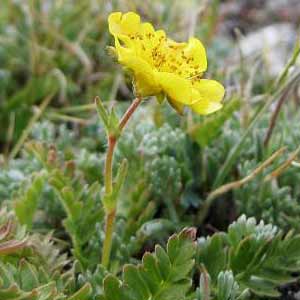Geum rossii
(synonym of Geum rossii var. depressum)
Rosaceae tribe Colurieae
Ross' avens
4–28 cm, glabrous or downy, hairs to 1 mm, sometimes septate-glandular.
basal 3–13 cm, blade pinnate to interruptedly pinnate, major leaflets 13–26, alternating with 0–14 minor ones, terminal leaflet slightly larger than major laterals;
cauline 0.7–2 cm, stipules adnate to leaf, indistinguishable from pair of lobes, blade bractlike, not resembling basal, alternate, simple, pinnatifid to 3-fid.
alternate, sometimes opposite (Geum), pinnately compound or simple;
stipules persistent, ± free or ± adnate to petiole;
venation pinnate or palmate.
1–3(–4)-flowered.
woolly, sometimes glandular.
erect;
epicalyx bractlets 1.5–7 mm;
hypanthium green, slightly purple-tinged to strongly purple;
sepals erect to erect-spreading, 3–10 mm;
petals spreading, yellow, obovate to nearly orbiculate, 5–12(–17) mm, longer than sepals, apex broadly rounded to irregularly emarginate.
perianth and androecium perigynous;
epicalyx bractlets absent or present;
hypanthium funnelform, saucer- to cup-shaped, or obconic to obcampanulate;
torus usually enlarged;
carpels (2 or)3–250(–450), styles terminal (subterminal in Waldsteinia), distinct;
ovules 1 or 2, basal, superposed.
sessile, glabrous.
wholly persistent, not geniculate-jointed, 2–5(–10) mm, apex not hooked, glabrous throughout or pilose only at base.
aggregated achenes;
styles persistent, sometimes deciduous (Waldsteinia), elongate, sometimes hooked, glabrous or hairy, rarely plumose.
= 56.
Geum rossii
Rosaceae tribe Colurieae
The variability accommodated here in Geum rossii was distributed by earlier monographers such as P. A. Rydberg (1913b) and F. Bolle (1933) among a half dozen species. W. Gajewski (1957) reduced them to two species, G. rossii and G. turbinatum; most recent taxonomists have recognized the two taxa as subspecies or varieties of a single species. The large geographic discontinuity between the Rocky Mountain and arctic ranges makes it easy for those wishing to follow this tradition. No one morphologic character or combination of characters neatly separates the arctic plants from those of the Rockies.
Where their ranges overlap in Alaska, Geum rossii hybridizes with G. calthifolium to form sterile plants known as G. ×macranthum (Kearney ex Rydberg) B. Boivin; see discussion under 4. G. schofieldii.
(Discussion copyrighted by Flora of North America; reprinted with permission.)
Genera 4, species ca. 60 (4 genera, 22 species in the flora).
Waldsteinia is recognized as distinct from Geum in this treatment, while D. Potter et al. (2007) included the former in the latter. Names are provided for users who would prefer to include Waldsteinia within Geum, as supported by molecular data (J. E. E. Smedmark and T. Eriksson 2002).
The base chromosome number for Colurieae is x = 7. Except for Fallugia, the genera of Colurieae are host to Phragmidium rusts. C. Kalkman (2004) stated that two ovules had been reported for Fallugia but that he observed only one, which would accord better with membership in Colurieae.
(Discussion copyrighted by Flora of North America; reprinted with permission.)
1. Shrubs, 10–20(–35) dm; leaves simple; flowers all pistillate, all staminate, or staminate with terminal one bisexual. | Fallugia |
1. Herbs or subshrubs, 0.2–12 dm; leaves simple, sometimes lobed, or ternately or pinnately compound; flowers bisexual | → 2 |
2. Subshrubs; inflorescences: flowers solitary. | Sieversia |
2. Herbs; inflorescences 1–18-flowered, open cymes or panicles | → 3 |
3. Plants subscapose or leafy-stemmed; tori hemispheric to cylindric; carpels (2–)20–250(–450); fruiting styles persistent, elongating, hooked or not. | Geum |
3. Plants scapose; tori not evident; carpels 3–7; fruiting styles deciduous, not hooked. | Waldsteinia |
- Local floras:
BC,
OR,
WA
- Local Web sites:
CalFlora,
CalPhotos,
Flora NW,
PNW Herbaria
WildflowerSearch
iNaturalist (observations)
USDA Plants Database
- LBJ Wildflower Center
- SEINet
- Plants of the World Online
- Encyclopedia of Life
- Wikipedia
- Google Image Search
